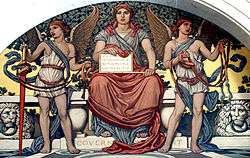Negative interest on excess reserves
| Public finance |
|---|
 |
|
Reform |
Negative interest on excess reserves is an instrument of unconventional monetary policy applied by monetary authorities in order to encourage lending by making it costly for commercial banks to hold their excess reserves at central banks.[1] Such policy can be associated with very slow economic growth, deflation, and deleverage.[2][3]
Examples
Europe
The European Central Bank and central banks of other European countries, such as Sweden, Switzerland, and Denmark, have paid negative interest on excess reserves—in effect taxing banks for exceeding their reserve requirements—as an expansionary monetary policy measure.[4][5][6][7][8]
Japan
In January 2016, the Bank of Japan followed other European central banks and lowered its interest rates below zero, after several years of keeping them at the lower end of the positive range.[9] The existing balances will keep on yielding a rate of 0.1 percent; the reserves that banks are required to keep at the BOJ will have a rate of zero percent, and a rate of minus 0.1 percent will be applied to any other reserves.
See also
- Excess reserves
- Forward guidance
- IOER – interest on excess reserves
- Negative interest rate
- Zero interest rate policy (ZIRP)
References
- ↑ "Negative interest rates in Europe: A Glance at Their Causes and Implications" (PDF). World Bank. worldbank.org. June 2015. Retrieved 5 February 2016.
- ↑ Roubini, Nouriel (January 14, 2016). "Troubled Global Economy". Time Magazine. time.com. Retrieved 5 February 2016.
- ↑ Dent Jr., Harry (February 5, 2016). "Negative Interest Rates Are the Next Stage in Global Stimulus". Economy & Markets. economyandmarkets.com. Retrieved 9 February 2016.
- ↑ Ward, Andrew; Oakley, David (27 August 2009). "Bankers watch as Sweden goes negative". Financial Times. London.
- ↑ Goodhart, C.A.E. (January 2013). "The Potential Instruments of Monetary Policy" (PDF). Financial Markets Group Paper (Special Paper 219). London School of Economics. 9-10. ISSN 1359-9151. Retrieved 13 April 2013.
- ↑ Blinder, Alan S. (February 2012). "Revisiting Monetary Policy in a Low-Inflation and Low-Utilization Environment". Journal of Money, Credit and Banking. 44 (Supplement s1): 141–146. doi:10.1111/j.1538-4616.2011.00481.x. Retrieved 13 April 2013.
- ↑ Thoma, Mark (August 27, 2012). "Would Lowering the Interest Rate on Excess Reserves Stimulate the Economy?". Economist's View. Retrieved 13 April 2013.
- ↑ Parameswaran, Ashwin. "On The Folly of Inflation Targeting In A World Of Interest Bearing Money". Macroeconomic Resilience. Retrieved 13 April 2013.
- ↑ Mayger, James (January 29, 2016). "Bank of Japan's Negative Interest Rate Decision Explained". Bloomberg. bloomberg.com. Retrieved 5 February 2016.
External links
- Why has the ECB introduced a negative interest rate? (European Central Bank, June, 2014)
- "The ECB's Negative Interest Rate: The Fed May Be Forced To Follow Its Lead" (former Dallas Federal Reserve President Bob McTeer, Forbes, June 5, 2014)
- "Will the European Central Bank’s negative interest rate be an economic positive?" (Simone Pathe, PBS Newshour, June 9, 2014)
- "Japan adopts negative interest rates in surprise move". BBC. 29 January 2016. Retrieved 29 January 2016.